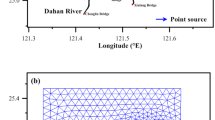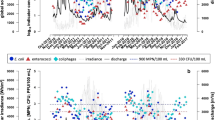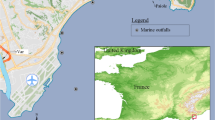Abstract
Climate change is one of the key factors affecting the future microbiological water quality in rivers and tidal estuaries. A coupled 3D hydrodynamic and fecal coliform transport model was developed and applied to the Danshuei River estuarine system for predicting the influences of climate change on microbiological water quality. The hydrodynamic and fecal coliform model was validated using observational salinity and fecal coliform distributions. According to the analyses of the statistical error, predictions of the salinity and the fecal coliform concentration from the model simulation quantitatively agreed with the observed data. The validated model was then applied to predict the fecal coliform contamination as a result of climate change, including the change of freshwater discharge and the sea level rise. We found that the reduction of freshwater discharge under climate change scenarios resulted in an increase in the fecal coliform concentration. The sea level rise would decrease fecal coliform distributions because both the water level and the water volume increased. A reduction in freshwater discharge has a negative impact on the fecal coliform concentration, whereas a rising sea level has a positive influence on the fecal coliform contamination. An appropriate strategy for the effective microbiological management in tidal estuaries is required to reveal the persistent trends of climate in the future.












Similar content being viewed by others
References
Bahr, D. B., Dyurgerov, M., & Meier, M. F. (2009). Sea-level rise from glaciers and ice caps: a lower bound. Geophysical Research Letter, 36(3).
Bai, S., & Lung, W. S. (2005). Modeling sediment impact on the transport of fecal bacteria. Water Research, 39(20), 5232–5240.
Bhuiyan, M. J. A. N., & Dutta, D. (2012). Assessing impacts of sea level rise on river salinity in the Gorai river network, Bangladesh. Estuarine, Coastal and Shelf Science, 96(1), 219–227.
Canteras, J. C., Juanes, J. A., Perez, L., & Koev, K. N. (1995). Modelling the coliforms inactivation rates in the Cantabrian Sea (Bay of Biscay) from in situ and laboratory determination of T90. Water Science and Technology, 32, 37–44.
Characklis, G. W., Dilts, M. J., Simmons, O. D., Likirdopulos, C. A., Krometis, L. A. H., & Sobsey, M. D. (2005). Microbial partitioning to settleable particles in stormwater. Water Research, 39(9), 1773–1782.
Chau, K. W. (2005). An unsteady three-dimensional eutrophication model in Tolo harbour, Hong Kong. Marine Pollution Bulletin, 51(8–12), 1078–1084.
Church, J. A., & White, N. J. (2011). Sea-level rise from the late 19th to the early 21st century. Survey in Geophysics, 32(4–5), 585–602.
Cronin, T. M. (2012). Rapid sea-level rise. Quaternary Science Reviews, 56, 11–30.
Fries, J. S., Characklis, G. W., & Noble, R. T. (2006). Attachment of fecal indicator bacteria to particles in the Neuse River estuary, N.C. Journal of Environmental Engineering, ASCE, 132(10), 1338–1345.
Gao, G., Falconer, R. A., & Lin, B. (2011). Numerical modelling of sediment-bacteria interaction processes in surface waters. Water Research, 45(5), 1951–1960.
Gao, G., Falconer, R. A., & Lin, B. (2013). Modelling effects of a tidal barrage on water quality indicator distribution in the Severn Estuary. Frontiers of Environmental Science and Engineering, 7(2), 211–218.
Gao, G., Falconer, R. A., & Lin, B. (2015). Modelling the fate and transport of faecal bacteria in estuaries and coastal waters. Marine Pollution Bulletin.
Garcia, A., Juanes, J. A., Alvarez, C., Revilla, J. A., & Medina, R. (2010). Assessment of the response of a shallow macrotidal estuary to changes in hydrological and wastewater inputs through numerical modeling. Ecological Modelling, 221(8), 1194–1208.
Hong, B., & Shen, J. (2012). Responses of estuarine salinity and transport processes to potential future sea-level rise in the Chesapeake Bay. Estuarine, Coastal and Shelf Science, 104–105, 33–45.
Hsu, M. H., Kuo, A. Y., Kuo, J. T., & Liu, W. C. (1999). Procedure to calibrate and verify numerical models of estuarine hydrodynamics. Journal of Hydraulic Engineering, ASCE, 125(2), 166–182.
Johnston, K. K., Dorsey, J. H., & Saez, J. A. (2015). Stratification and loading of fecal indicator bacteria (FIB) in a tidally muted urban salt marsh. Environmental Monitoring and Assessment, 187(3), 58.
Jones, R. M., Liu, L., & Dorevitch, S. (2013). Hydrometeorological variables predict fecal indicator bacteria densities in freshwater: data-driven methods for variable selection. Environmental Monitoring and Assessment, 185(3), 2355–2366.
Kashefipour, S. M., Lin, B., Harris, E., & Falconer, R. A. (2002). Hydro-environmental modelling for bathing water compliance of an estuarine basin. Water Research, 36(7), 1854–1868.
Liu, W. C., & Chan, W. T. (2014). Assessing the influence of nutrient reduction on water quality using a three-dimensional model: case study in a tidal estuarine system. Environmental Monitoring and Assessment, 186(12), 8807–8825.
Liu, W. C., & Huang, W. C. (2012). Modeling the transport and distribution of fecal coliform in a tidal estuary. Science of the Total Environment, 431, 1–8.
Liu, W. C., & Liu, H. M. (2014). Assessing the impacts of sea level rise on salinity intrusion and transport time scales in a tidal estuary, Taiwan. Water, 6(2), 324–344.
Liu, W. C., Liu, S. Y., Hsu, M. H., & Kuo, A. Y. (2005). Water quality modeling to determine minimum instream flow for fish survival in tidal rivers. Journal of Environment Management, 76(4), 293–308.
Liu, L., Phanikumar, M. S., Molloy, S. L., Whitman, R. L., Shively, D. A., Nevers, M. B., Schwab, D. J., & Rose, J. B. (2006). Modeling the transport and inactivation of E. coli and Enterococci in the near-shore region of Lake Michigan. Environmental Science and Technology, 40(16), 5022–5028.
Liu, W. C., Chen, W. B., & Hsu, M. H. (2011). Influence of discharge reductions on salt water intrusion and residual circulation in Danshuei River Estuary. Journal of Marine Science and Technology, 19(6), 596–606.
Long, T. Y., Wu, L., Meng, G. H., & Guo, W. H. (2011). Numerical simulation for impacts of hydrodynamic conditions on algae growth in Chongqing Section of Jialing River, China. Ecological Modelling, 222(1), 112–119.
McGlathery, K. J., Sundback, K., & Anderson, I. C. (2007). Eutrophication in shallow coastal bay and lagoons: the role of plants in the coastal filter. Marine Ecology Progress Series, 348, 1–18.
Moss, R. H., Edmonds, J. A., Hibbard, K. A., Manning, M. R., Ross, S. K., Van Vuuren, D. P., Carter, T. R., Emori, S., Kainuma, M., Kram, T., Meehl, G. A., Mitchell, J. F. B., Nakicenovic, N., Riahi, K., Smith, S. J., Stouffer, R. J., Thomson, A. M., Weyant, J. P., & Wilbanks, T. J. (2010). The next generation of scenarios for climate change research and assessment. Nature, 463(7282), 747–756.
Nicholls, R. J., & Cazenave, A. (2010). Sea-level rise and its impact on coastal zone. Science, 328(5985), 1517–1520.
Paliwal, R., & Patra, R. R. (2011). Applicability of MIKE 21 to assess temporal and spatial variation in water quality of an estuary under the impact of effluent from an industrial estate. Water Science and Technology, 63(9), 1932–1943.
Pendleton, L. H. (2008). The economic and market value of coasts and estuaries: what’s at stake? Restore America’s Estuaries, 182p.
Poff, N. L., Brinson, M. M., & Day Jr, J. W. (2002). Aquatic ecosystems and global climate change. Pew Center on Global Change, 45 pp.
Rice, K. C., Hong, B., & Shen, J. (2012). Assessment of salinity intrusion in the James and Chickahominy Rivers as a result of simulated sea-level rise in Chesapeake Bay, East Coast, USA. Journal of Environmental Management, 111, 61–69.
Rodrigues, M., Oliveira, A., Guerreiro, M., Fortunato, A. B., Menaia, J., David, L. M., & Cravo, A. (2011). Modeling fecal contamination in the Aljezur coastal stream (Portugal). Ocean Dynamics, 61(4), 841–856.
Rozen, Y., & Belkin, S. (2001). Survival of enteric bacteria in seawater. FEMS Microbiology Reviews, 25, 513–529.
Servais, P., Garcia-Armisen, T., George, I., & Billen, G. (2007). Fecal bacteria in the rivers of the Seine drainage network (France): sources, fate and modeling. Science of the Total Environment, 375(1–3), 152–157.
Shchepetkin, A. F., & McWilliams, J. C. (2003). A method for computing horizontal pressure-gradient force in an oceanic model with a nonaligned vertical coordinate. Journal of Geophysical Research, 108(C3), 3090.
Skerratt, J., Wild-Allen, K., Rizwi, F., Whitehead, J., & Coughanowr, C. (2013). Use of a high resolution 3D fully coupled hydrodynamic, sediment and biogeochemical model to understand estuarine nutrient dynamics under various water quality scenarios. Ocean and Coastal Management, 83, 52–66.
Snay, R., Cline, M., Dillinger, W., Foote, R., Hilla, S., Kass, W., Ray, J., Rohde, J., Sella, G., & Soler, T. (2007). Using global positions system-derived crustal velocities to estimate rates of absolute sea level change from North American tidal gauge records. Journal of Geophysical Research, 112(B4), B04409.
Sokolova, E., Pettersson, T. J. R., Bergstedt, O., & Hermansson, M. (2013). Hydrodynamic modelling of the microbial water quality in a drinking water sources as input for risk reduction management. Journal of Hydrology, 497, 15–23.
Steets, B. M., & Holden, P. A. (2003). A mechanistic model of runoff-associated fecal coliform fate and transport through a coastal lagoon. Water Research, 37(3), 589–608.
Thomann, R. V., & Mueller, J. A. (1987). Principles of surface water quality and control. New York: Harper Collins.
Trenberth, K. E. (2012). Framing the way to relate climate extremes to chimate change. Climate Change, 115(2), 283–290.
Umlauf, L., & Buchard, H. (2003). A generic length-scale equation for geophysical turbulence models. Journal of Marine Research, 61(2), 235–265.
Wang, C. F., Hsu, M. H., Liu, W. C., Hwang, J. S., Wu, J. T., & Kuo, A. Y. (2007). Simulation of water quality and plankton dynamics in the Danshuei River Estuary, Taiwan. Journal of Environmental Science and Health, Part A, 42(7), 933–953.
Water Resources Agency (2008). Strengthening sustainable water resources utilization and adaptive capability to climate change. Final Report. (in Chinese).
Wetz, M. S., & Yoskowitz, D. W. (2013). An ‘extreme’ future for estuaries? Effects of extreme climate events on estuarine water quality and ecology. Marine Pollution Bulletin, 69(1–2), 7–18.
Whitehead, P., Wade, A., & Butterfield, D. (2009). Potential impacts of climate change on water quality and ecology in six UK rivers. Hydrology Research, 40(2–3), 113–122.
Wild-Allen, K., Skerratt, J., Whitehead, J., Rizwi, F., & Parslow, J. (2013). Mechanisms driving estuarine water quality: a 3D biogeochemical model for informed management. Estuarine, Coastal and Shelf Science, 135, 33–45.
Wu, Y., Liu, S., & Gallant, A. L. (2012). Predicting impacts of increased CO2 and climate change on the water cycle and water quality in the semiarid James River Basin of the Midwestern USA. Science of the Total Environment, 430, 150–160.
Yan, T., & Sadowsky, M. J. (2006). Determining sources of fecal bacteria in waterways. Environmental Monitoring and Assessment, 129(1–3), 97–106.
Yoskowitz, D., Santos, C., Allee, B., Carollo, C., Henderson, J., Jordan, S., & Ritchie, J. (2010). Proceedings of the Gulf of Mexico ecosystem services workshop: Bay St. Louis (pp. 16–18). Mississippi: Harte Research Institute for Gulf of Mexico Studies. 16 P.
Yu, Y. F., Yu, Y. X., Zuo, J. C., Wan, Z. W., & Chen, Z. Y. (2003). Effect of sea level variation on tidal characteristic values for the East China Sea. China Ocean Engineering, 17(3), 369–382.
Zhang, Y. L., & Baptista, A. M. (2008). SELFE: a semi-implicit Eulerian–Lagrangian finite-element model for cross-scale ocean circulation. Ocean Modelling, 21(3–4), 71–96.
Zhou, N., Westrich, B., Jiang, S., & Wang, Y. (2010). A coupling simulation based on hydrodynamics and water quality model of the Pearl River Delta, China. Journal of Hydrology, 396(3), 267–276.
Acknowledgments
This study was supported in part by the Taiwan’s Ministry of Science and Technology under grant no. 103-2625-M-239-002. This financial support is greatly appreciated. The authors also thank the Taiwan Water Resources Agency and Environmental Protection Administration for providing the observed data used in our model validation.
Author information
Authors and Affiliations
Corresponding author
Rights and permissions
About this article
Cite this article
Liu, WC., Chan, WT. Assessment of the climate change impacts on fecal coliform contamination in a tidal estuarine system. Environ Monit Assess 187, 728 (2015). https://doi.org/10.1007/s10661-015-4959-7
Received:
Accepted:
Published:
DOI: https://doi.org/10.1007/s10661-015-4959-7




